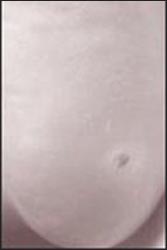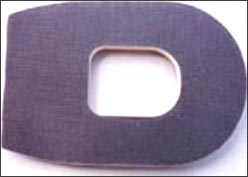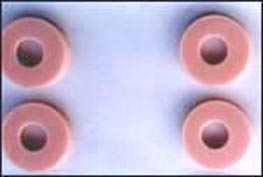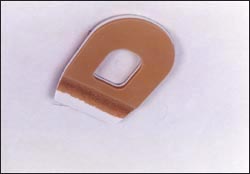티눈, Corns
티눈의 원인
- 발바닥이나 손바닥의 피부의 각질층(표피층)의 일부가 국소적으로 두꺼워진 상태의 피부를 티눈이라고 한다.
- 티눈은 발바닥에 주로 생긴다.
- 발에 잘 맞지 않는 신발을 신을 때 그 신발이 발바닥의 일부와 계속 마찰되면 마찰된 발바닥 부위의 피부의 각질층이 비정상적으로 두꺼워져서 티눈이 생긴다.
- 발에 있는 어떤 선천성 기형 부위가 신발에 마찰되어 티눈이 생길 수 있다.
티눈의 증상 징후

사진 452. 발에 난 티눈은 죽은 피부층의 표피층의 세포로 형성되고 발바닥 사마귀는 바이러스 감염으로 생긴 일종의 피부 종양이다. 발바닥 사마귀 속에 모세혈관이 있고 티눈 속에는 모세혈관이 없다.
Copyrightⓒ 2012 John Sangwon Lee, MD., FAAP

사진 453. 발바닥 사마귀(족척 우체)발바닥 사마귀 속에 모세혈관이 있고 티눈 속에는 모세혈관이 없다. 그래서 사마귀에 출혈반점이 생겨 중앙부가 검게 보인다.
Copyrightⓒ 2012 John Sangwon Lee, MD., FAAP

사진 454. 발에 난 티눈이나 발바닥 사마귀로 걸을 때 아플 수 있다. 이때 쓸 수 있는 패드.
Copyrightⓒ 2012 John Sangwon Lee, MD., FAAP

사진 455. 발에 난 티눈이나 발바닥 사마귀로 아플 때 이런 원형 패드로 티눈이나 사마귀 난 부위에 붙일 수 있다.
Copyrightⓒ 2012 John Sangwon Lee,MD., FAAP
- 일반적으로 티눈이 작을 때는 증상 징후가 거의 없다.
- 큰 티눈이 있는 발로 걸을 때 티눈 바로 아래 신경이 티눈으로 눌려 발이 아플 수 있다.
티눈의 진단, 치료
- 병력·증상 징후와 진찰소견 등을 종합해서 진단한다.
- 발에 난 티눈과 발바닥 사마귀를 감별 진단해야 한다.
- 발바닥 사마귀 끝 부분의 모세혈관들이 터지거나 확장돼 출혈이 생길 수 있다.
- 그런 출혈로 사마귀의 끝 부위가 검붉을 수 있다.
- 티눈 끝 부분에는 모세혈관이 없다.
- 또한 피가 맺히지 않기 때문에 티눈 끝 부분의 색은 발바닥 피부색과 거의 같거나 회백색인 것이 보통이다.
- 티눈이 발에 맞지 않는 신발로 생겼을 때는 잘 맞는 신발을 신는다.
- 선천성 발 기형 또는 후천성 발 기형으로 발바닥에 티눈이 생기면 발 기형 정형 치료를 받거나 기형이 있는 발에 알맞은 신발을 신는다. 그리고 선천성 또는 후천성 발의 기형에 따라 정형외과 전문의 치료를 받아야 한다.
- 잠자기 전에 티눈이 있는 발을 따뜻한 물에 10∼20분 간 담근 후 티눈의 각질층을 둔한 칼날로 살살 긁어 티눈을 뺄 수 있다.
- 또 발바닥 사마귀를 뺄 때 쓰는 두오필름 등 외용 약물을 발라 티눈을 빼줄 수 있다.
- 도넛 모양 패드를 신발 속에 넣고 걸으면 티눈으로 생기는 통증이 덜 할 수 있다.
- 또 티눈이 맞닿는 발바닥 패드 부위에 구멍을 둥글게 뚫고 그 패드를 신발 안창에 깔고 신으면 티눈이 신발 바닥에 직접 닿지 않기 때문에 덜 아프다.

사진 456. 발에 난 티눈이나 발바닥사마귀로 발이 아플 때 쓸 수 있는 패드.
Copyrightⓒ 2012 John Sangwon Lee, MD., FAAP
Corns
Causes of corns
• The skin in which a part of the stratum corneum (epidermis) of the skin on the soles of the feet or palms is locally thickened is called corn.
• Corns occur mainly on the soles of the feet.
• If you wear shoes that do not fit your feet and the shoes continue to rub against the soles of the feet, the stratum corneum of the skin on the rubbed soles becomes abnormally thick, resulting in corns.
• Certain congenital anomalies on the foot can cause corns to rub against the shoe.
Symptoms of Corns Signs

Picture 452. Corns on the feet are formed from cells in the epidermal layer of the dead skin layer, and plantar warts are a kind of skin tumor caused by a viral infection. There are capillaries in the plantar warts and there are no capillaries in the corns. Copyright© 2012 John Sangwon Lee, MD., FAAP

Picture 453. Plantar wart (foot wart) There are capillaries in the plantar wart and there are no capillaries in the corn. Therefore, bleeding spots appear on the wart and the central part looks black. Copyright© 2012 John Sangwon Lee, MD., FAAP

Picture 454. Corns on the feet or plantar warts that can hurt when walking. A pad that can be used at this time. Copyright© 2012 John Sangwon Lee, MD., FAAP

Picture 455. When you are suffering from corns or plantar warts on your feet, you can use these circular pads to attach to the corns or warts. Copyrightⓒ 2012 John Sangwon Lee, MD., FAAP
• Small corns usually have few symptoms
. • When walking with a large corned foot, the nerve just below the corn is compressed by the corn, which may cause pain in the foot.
Diagnosis and treatment of corns
• Diagnosis is made by combining medical history, symptoms, signs, and examination findings.
• Differential diagnosis should be made for corns on the feet and plantar warts.
• The capillaries at the tip of the plantar wart can rupture or dilate, causing bleeding.
• Such bleeding can cause the tip of the wart to be dark red.
• There are no capillaries at the tip of the corn. • Also, since there is no blood, the color of the tip of the corn is usually the same as the skin color of the sole or grayish white.
• If your corns look like shoes that don’t fit your feet, wear shoes that fit well.
• If corns are formed on the soles of the feet due to congenital or acquired foot deformities, seek treatment for foot deformities or wear shoes suitable for the deformed feet. In addition, depending on the congenital or acquired foot deformity, treatment by an orthopedic specialist is required.
• Before going to sleep, soak your feet in warm water for 10 to 20 minutes and then gently scrape the stratum corneum of the corn with a dull blade to remove the corns. • You can also remove corns by applying external drugs such as Doofilm, which is used to remove plantar warts.
• Putting donut-shaped pads in your shoes while walking may reduce corneal pain.
• Also, if you drill a hole in the pad area of the sole where the corn touches and put the pad on the insole of the shoe, it is less painful because the corn does not directly touch the sole of the shoe.

Photo 456. A pad that can be used when your feet hurt from corns or plantar warts on your feet. Copyright © 2012 John Sangwon Lee, MD., FAAP
출처 및 참조 문헌 Sources and references
- NelsonTextbook of Pediatrics 22ND Ed
- The Harriet Lane Handbook 22ND Ed
- Growth and development of the children
- Red Book 32nd Ed 2021-2024
- Neonatal Resuscitation, American Academy of Pediatrics
- www.drleepediatrics.com 제1권 소아청소년 응급 의료
- www.drleepediatrics.com 제2권 소아청소년 예방
- www.drleepediatrics.com 제3권 소아청소년 성장 발육 육아
- www.drleepediatrics.com 제4권 모유,모유수유, 이유
- www.drleepediatrics.com 제5권 인공영양, 우유, 이유식, 비타민, 미네랄, 단백질, 탄수화물, 지방
- www.drleepediatrics.com 제6권 신생아 성장 발육 육아 질병
- www.drleepediatrics.com제7권 소아청소년 감염병
- www.drleepediatrics.com제8권 소아청소년 호흡기 질환
- www.drleepediatrics.com제9권 소아청소년 소화기 질환
- www.drleepediatrics.com제10권. 소아청소년 신장 비뇨 생식기 질환
- www.drleepediatrics.com제11권. 소아청소년 심장 혈관계 질환
- www.drleepediatrics.com제12권. 소아청소년 신경 정신 질환, 행동 수면 문제
- www.drleepediatrics.com제13권. 소아청소년 혈액, 림프, 종양 질환
- www.drleepediatrics.com제14권. 소아청소년 내분비, 유전, 염색체, 대사, 희귀병
- www.drleepediatrics.com제15권. 소아청소년 알레르기, 자가 면역질환
- www.drleepediatrics.com제16권. 소아청소년 정형외과 질환
- www.drleepediatrics.com제17권. 소아청소년 피부 질환
- www.drleepediatrics.com제18권. 소아청소년 이비인후(귀 코 인두 후두) 질환
- www.drleepediatrics.com제19권. 소아청소년 안과 (눈)질환
- www.drleepediatrics.com 제20권 소아청소년 이 (치아)질환
- www.drleepediatrics.com 제21권 소아청소년 가정 학교 간호
- www.drleepediatrics.com 제22권 아들 딸 이렇게 사랑해 키우세요
- www.drleepediatrics.com 제23권 사춘기 아이들의 성장 발육 질병
- www.drleepediatrics.com 제24권 소아청소년 성교육
- www.drleepediatrics.com 제25권 임신, 분만, 출산, 신생아 돌보기
- Red book 29th-31st edition 2021
- Nelson Text Book of Pediatrics 19th- 21st Edition
- The Johns Hopkins Hospital, The Harriet Lane Handbook, 22nd edition
- 응급환자관리 정담미디어
- Pediatric Nutritional Handbook American Academy of Pediatrics
- 소아가정간호백과–부모도 반의사가 되어야 한다, 이상원 저
- The pregnancy Bible. By Joan stone, MD. Keith Eddleman, MD
- Neonatology Jeffrey J. Pomerance, C. Joan Richardson
- Preparation for Birth. Beverly Savage and Dianna Smith
- 임신에서 신생아 돌보기까지. 이상원
- Breastfeeding. by Ruth Lawrence and Robert Lawrence
- Sources and references on Growth, Development, Cares, and Diseases of Newborn Infants
- Emergency Medical Service for Children, By Ross Lab. May 1989. p.10
- Emergency care, Harvey Grant and Robert Murray
- Emergency Care Transportation of Sick and Injured American Academy of Orthopaedic Surgeons
- Emergency Pediatrics A Guide to Ambulatory Care, Roger M. Barkin, Peter Rosen
- Quick Reference To Pediatric Emergencies, Delmer J. Pascoe, M.D., Moses Grossman, M.D. with 26 contributors
- Neonatal resuscitation Ameican academy of pediatrics
- Pediatric Nutritional Handbook American Academy of Pediatrics
- Pediatric Resuscitation Pediatric Clinics of North America, Stephen M. Schexnayder, M.D.
-
Pediatric Critical Care, Pediatric Clinics of North America, James P. Orlowski, M.D.
-
Preparation for Birth. Beverly Savage and Dianna Smith
-
Infectious disease of children, Saul Krugman, Samuel L Katz, Ann A.
- 제4권 모유, 모유수유, 이유 참조문헌 및 출처
- 제5권 인공영양, 우유, 이유, 비타민, 단백질, 지방 탄수 화물 참조문헌 및 출처
- 제6권 신생아 성장발육 양호 질병 참조문헌 및 출처
- 소아과학 대한교과서
-
Copyright ⓒ 2014 John Sangwon Lee, MD., FAAP
“부모도 반의사가 되어야 한다”-내용은 여러분들의 의사로부터 얻은 정보와 진료를 대신할 수 없습니다.
“The information contained in this publication should not be used as a substitute for the medical care and advice of your doctor. There may be variations in treatment that your doctor may recommend based on individual facts and circumstances.
“Parental education is the best medicine.